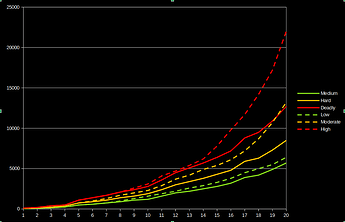Getting around to comparing the '14 and '24 versions of one of my most-referenced sections of the DMG: Combat Encounter Planning.
In DMG14, this starts on page 82; DBG24 starts it on page 114.
We have a pretty sizable change right off the bat: the '14 concept of “Adventuring Day XP” seems to be removed entirely in '24. For the uninitiated, this was intended as a per-character budget of XP gained from all sources before needing a long rest, assuming two short rests during the day. Since it’s now gone, I won’t bother describing it beyond saying that it was, as implemented, nonsensical - we’re probably better off for abandoning it.
The next big change is that '24 presents three difficulty levels (Low, Moderate, High) to DMG14’s four (Easy, Medium, Hard, Deadly). Based on the descriptions and thresholds, '24 dropped the “Easy” difficulty and re-labeled the old “Medium” into “Low.” The textual descriptions of the '24 difficulties are otherwise equivalent as in '14.
The budget thresholds are consistent with each other through Tier 1 and begin to diverge at different levels for each difficulty: Low at 8, Moderate at 6, High at 9. Here’s a visualization:
The dashed lines are the '24 budgets, '14 in solids, and using the same colors (sorry, I know color-based encoding isn’t as accessible as I’d like) for corresponding difficulty levels between year versions.
It’s pretty clear that '24 curves the difficulty quite differently, and higher, than '14, especially for Tier 3 & 4 play, but this isn’t the whole picture.
DMG14’s encounter guidance included XP adjustment multipliers based on the counts of monsters and party members. Applying those adjustments could get pretty bonkers at the edges, and was fairly tricky to build into a general use calculator (I actually did just that in a Rails app!). Under that system, the XP value of seven monsters against a party of 4 adventurers would get a 2x multiplier, presumably to try and quantify the effect of a numerical advantage. Similarly, a single monster squaring off against that party would have its XP halved (for calculating difficulty).
DMG24 has no adjustments for monster and party headcounts, though! It will be interesting to see how that plays out for encounter designers. It’s fairly common to design around one or two “boss-like” enemies with a CR at or slightly above the average party level (APL) and supply them with minions or reinforcements of much lower CR to try and split the party’s focus.
